
Lugano is a city and municipality in Switzerland, part of the Lugano District in the canton of Ticino. It is the largest city of both Ticino and the Italian-speaking southern Switzerland. Lugano has a population of 62,315, and an urban agglomeration of over 150,000. It is the ninth largest Swiss city.
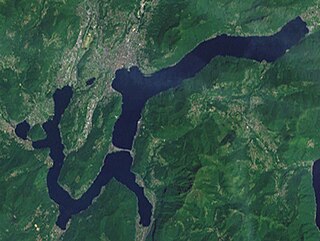
Lake Lugano is a glacial lake which is situated on the border between southern Switzerland and northern Italy. The lake, named after the city of Lugano, is situated between Lake Como and Lago Maggiore. It was cited for the first time by Gregory of Tours in 590 with the name Ceresio, a name which is said to have derived from the Latin word cerasus, meaning cherry, and refers to the abundance of cherry trees which at one time adorned the shores of the lake. The lake appears in documents in 804 under the name Laco Luanasco.

Gandria is both a quarter of the city of Lugano in the Swiss canton of Ticino, and a village on the northern shore of Lake Lugano, which forms the core of that quarter. Until 2004, the quarter of Gandria was an independent municipality, joining with Lugano in that year.

Capolago is a village situated at the south-eastern extremity of Lake Lugano, in the Swiss canton of Ticino. Originally a municipality in its own right, Capolago is now a quarter of the municipality of Mendrisio, itself part of the district of Mendrisio.
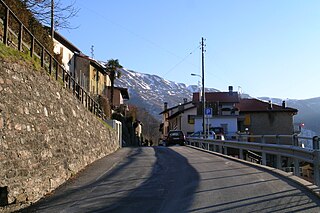
Valcolla is a quarter of the city of Lugano and former municipality in the district of Lugano in the canton of Ticino in Switzerland. On 14 April 2013 the former municipalities of Bogno, Cadro, Carona, Certara, Cimadera, Sonvico and Valcolla merged into the municipality of Lugano.
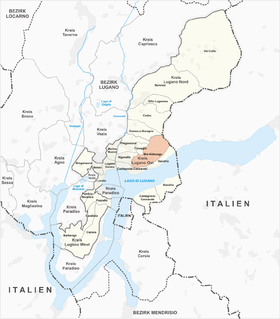
Brè-Aldesago is a quarter of the city of Lugano, in the Swiss canton of Ticino.
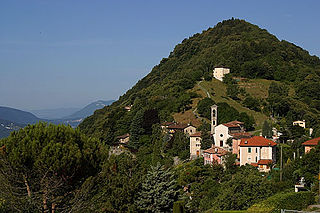
Brè is a village on the eastern slopes of the mountain of Monte Brè, in the Swiss canton of Ticino. Politically the village forms part of the Brè-Aldesago quarter of the city of Lugano, although until 1972 Brè-Aldesago was an independent municipality, known simply as Brè until 1953.

Castagnola is a village on the northern shore of Lake Lugano, below the mountain of Monte Brè, in the Swiss canton of Ticino. Politically the village forms part of the Castagnola-Cassarate quarter of the city of Lugano, although until 1972 Castagnola-Cassarate was an independent municipality under the name Castagnola.
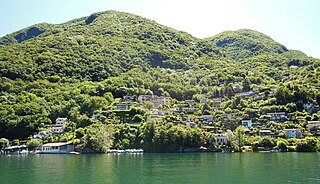
Caprino is a village on the southern shore of Lake Lugano in the Swiss canton of Ticino, to the east of the Italian exclave of Campione d'Italia and below the summit of Sighignola. Some 0.5 kilometres (0.31 mi) east of Caprino village is Cantine di Caprino, a smaller settlement. Politically both form part of the Castagnola-Cassarate quarter of the city of Lugano, although until 1972 Castagnola-Cassarate was an independent municipality under the name Castagnola.
Cassarate is a village on the northern shore of Lake Lugano, to the east of the outfall of the Cassarate River, in the Swiss canton of Ticino. Politically the village forms part of the Castagnola-Cassarate quarter of the city of Lugano, although until 1972 Castagnola-Cassarate was an independent municipality under the name Castagnola.

Breganzona is a quarter of the city of Lugano, Switzerland. Breganzona was formerly a municipality of its own, having been incorporated into Lugano in 2004. It was first recorded in 984 as Brianzona. The municipality had 232 inhabitants in 1850, which increased to 369 in 1900, 883 in 1950, 4,654 in 1990 and 4,782 in 2000.

Cureggia is a quarter of the city of Lugano, Switzerland. Cureggia was formerly a municipality of its own, having been incorporated into Lugano in 2004. It was first recorded in 1329 as Curezia.

Davesco-Soragno is a quarter of the city of Lugano, Switzerland. Davesco-Soragno was formerly a municipality of its own, having been incorporated into Lugano in 2004.

Pazzallo is a quarter of the city of Lugano in the Swiss canton of Ticino. Pazzallo was formerly a municipality of its own, having been incorporated into Lugano in 2004.

The Monte Brè funicular, or Funicolare Cassarate - Monte Brè, is a funicular railway in the city of Lugano in the Swiss canton of Ticino. The line links a lower station in the Lugano suburb of Cassarate with an upper station at the summit of the Monte Brè. The top yields views of the city and Lake Lugano.

Trasporti Pubblici Luganesi (TPL) is a public transport operator in and around the Swiss city of Lugano. Previously known as the Società luganese dei tramway elettrici, Tranvie elettriche comunali, Azienda comunale del traffico (ACT) and Azienda comunale dei trasporti della Città di Lugano (ACTL), the organisation was founded in 1884 and adopted its current name in 2000.

Aldesago is a village on the western slopes of the mountain of Monte Brè, in the Swiss canton of Ticino. Politically the village forms part of the Brè-Aldesago quarter of the city of Lugano, although until 1972 Brè-Aldesago was an independent municipality.

Besso is a quarter of the city of Lugano, in the Swiss canton of Ticino. It forms the part of the city which is uphill of Lugano railway station, and is separated from the city centre by that station and its rail approaches. Besso was developed as a residential area in the late nineteenth century, driven by the opening of the railway in 1882. By 2011, it had a population of 4,993.
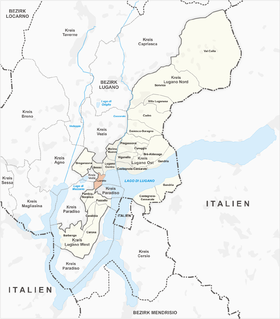
Loreto is a quarter of the city of Lugano, in the Swiss canton of Ticino. It forms the part of the city which surrounds the shrine of Our Lady of Loreto to the south of the city center, and includes the Lake Lugano waterfront south of the city centre but north of Paradiso. In 2011, it had a population of 3,221.

Molino Nuovo is a quarter of the city of Lugano, in the Swiss canton of Ticino. It lies to the north of the city center, and is the most populous quarter of the city. In 2012, it had a population of 9,258.





















